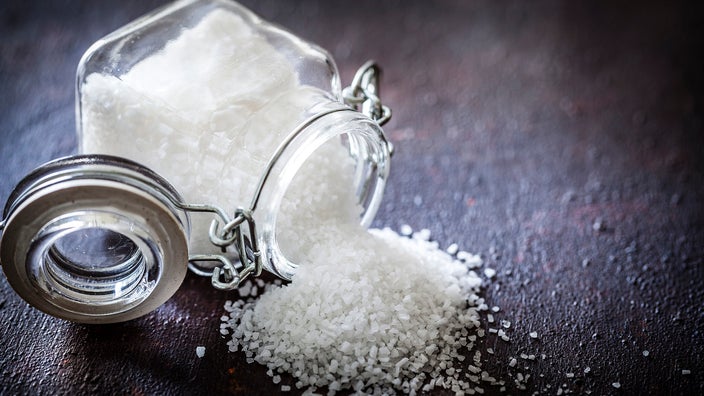
Low Sodium: Symptoms, Causes, and Treatment Options
Key takeaways:
Sodium is an electrolyte that balances the amount of fluid in the body, helps muscles and nerves work, and regulates blood pressure.
The term for low sodium levels in the blood is hyponatremia. And there are many different causes, such as changes in kidney function, blood pressure medications, or conditions like heart or liver failure.
Symptoms of low sodium levels include nausea, fatigue, dizziness, vomiting, forgetfulness, confusion, and muscle cramps. Extremely low sodium levels can cause seizures, coma, and death.
The seriousness of hyponatremia depends on how low sodium levels are and how quickly they change. This condition can range from very mild to severe.
Access savings on related medications
Table of contents

You may be wondering what hyponatremia is. Hyponatremia is a combination of the Greek word for low (hypo) and the Latin word for sodium (natrium). In other words, it’s simply a fancy way to say “low sodium.” Sodium is a basic element naturally found in many foods. It’s one of several nutrients essential for the body to function, and it’s the main determinant of the balance of water in the body.
But it has many jobs beyond this, including regulating blood pressure and muscle contraction. Although you can get sodium from your diet, the body has many ways to maintain the right amount of sodium in the body. When sodium levels become abnormal, there can be important health consequences.
Here, we will review reasons why sodium levels can get too low, and what it means when this happens.
Low sodium (hyponatremia) symptoms
The symptoms of low sodium are related to the way it causes fluid shifts in the brain. The severity of sodium deficiency symptoms depends on both the sodium levels and how fast sodium levels change.
Your body can usually adapt to small changes in sodium levels over time. Rapid changes in sodium (that happen over 1 to 2 days) tend to be more dangerous, since your body doesn’t have time to adjust to fluid shifts.
Abrupt changes in sodium levels can lead to symptoms that range from mild to severe.
Mild symptoms: nausea, fatigue, dizziness, muscle cramps, and headaches
Severe symptoms: vomiting, lethargy, confusion, disorientation, and hallucinations
Very severe symptoms: seizures, coma, respiratory arrest (stopping breathing)
The symptoms of chronic hyponatremia, which happens over several days to weeks, are usually less severe. And they may also be less easy to recognize since they’re not very specific. Some symptoms of chronic hyponatremia are:
Fatigue
Nausea
Dizziness
Vomiting
Difficulty walking/falls
Confusion or being forgetful
Muscle cramps
Low-sodium diet: Here’s how to lower your sodium by following a low-sodium diet.
Can too much water affect your sodium? Find out how drinking too much water can cause low sodium levels.
How much salt is too much? Learn how much salt you need to keep your body healthy.
What causes low sodium (hyponatremia)?
Sodium levels in the blood are affected by how much sodium you eat or how much water you drink. However, the body adjusts for variations in the diet in order to maintain normal sodium levels. Below are some of the common causes of hyponatremia.
Kidney problems
The kidneys play a critical role in controlling the amount of sodium and water in the blood. So, the most common reason for low sodium is a kidney problem. When the kidneys are not functioning normally, which can be seen in chronic kidney disease or even temporary dehydration, the body holds too much water. And the proportion of sodium compared to water in the body lowers the sodium level.
Medications
Low sodium can also be a side effect of some drugs and medications. These include:
Diuretics, which are commonly prescribed for high blood pressure or heart failure
Angiotensin-converting enzyme inhibitors (ACE inhibitors), another common blood pressure medication
Antidepressants, especially selective serotonin reuptake inhibitors (SSRIs)
Some antipsychotics and antiepileptics
Amiodarone, a heart medicine that helps to regulate the heart rhythm
Theophylline, a medicine for people with certain lung conditions
Intravenous fluids
Certain recreational drugs, like ecstasy (methylenedioxymethamphetamine)
Medical conditions
Certain medical conditions can put people at higher risk of hyponatremia. Some examples of these include:
Conditions that can cause the body to hold onto too much fluid, like heart failure or liver cirrhosis
Diarrhea, which can cause your body to lose a lot of electrolytes
Syndrome of inappropriate antidiuretic hormone secretion (SIADH), which causes the body to retain water
Having low levels of certain hormones like thyroid hormone, cortisol, or aldosterone
Drinking too much water — although this is uncommon and mostly seen in people with psychiatric conditions or in athletes who overhydrate after intense exercise
Lab measurement error
Abnormal sodium levels may also result from measurement errors. Your primary care provider needs to look at the big picture if your sodium level is low. High blood sugar can make sodium levels appear low, even if the total amount of sodium in the body is normal. Having very high lipid levels in the blood can also lead to incorrect sodium measurements.
What are normal sodium levels?
A normal sodium level is any number between 135 mEq/L and 145 mEq/L. Sodium levels are easily measured on routine blood tests that measure electrolytes.
When are low sodium levels considered too low?
The definition of low sodium is a blood level that’s lower than 135 mEq/L. In the case of chronic or long-standing hyponatremia, most people don’t have symptoms unless the level is less than 120 mEq/L. Your primary care provider can also run other blood tests or urine tests to better understand the cause of your low sodium levels.
Hyponatremia is always diagnosed with a blood test, usually a blood electrolyte panel. A healthcare professional might check your sodium levels routinely if you are on a medication that can cause low sodium. Or it may be discovered on a blood test that’s ordered for a different reason.
How do you treat low sodium levels?
The most important treatment for low sodium is treating the underlying cause. Your primary care provider will make sure you’re getting the best treatment for your illness while correcting your sodium levels.
In cases of mild hyponatremia, you may not need immediate treatment. You may just have the amount of sodium in your blood checked periodically. If the low sodium is caused by medication, you may have certain medications stopped or changed. If you must be on a medication that causes your sodium to be low, your healthcare professional might recommend dietary changes. Or they may recommend you take sodium supplements or limit the amount of water you drink. However, it’s best to only make these changes under the guidance of a healthcare professional.
People with extremely low sodium levels or with severe symptoms should be treated in the hospital, where they can receive medications and intravenous fluids to help bring sodium levels back to normal in a gradual and safe way.
The bottom line
Sodium is a vital nutrient that plays an important role in many bodily functions. So, when levels get too low, it can cause some problems — particularly with fluid levels, blood pressure, and brain function.
Some common medical problems and medications can lower sodium levels. And, for most people, their symptoms will be mild, and the problem can easily be fixed. But more serious cases will lead to noticeable symptoms, and these cases are best treated in the hospital.
Why trust our experts?



References
Goh, K. P. (2004). Management of hyponatremia. American Family Physician.
National Kidney Foundation. (n.d.). Hyponatremia (low sodium level in the blood).
Sterns, R. (2015). Disorders of plasma sodium — Causes, consequences, and correction. New England Journal of Medicine.


